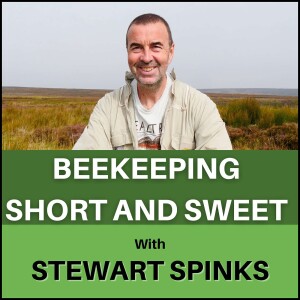
Episode 39: November Jobs, Fat and Thirsty Bees!
 2018-11-23
2018-11-23
I’m sure you don’t need me to tell you Autumn has finally arrived and last weekend here in the UK, we turned our clocks back. With the turning back of the clocks we suddenly got hit with some colder weather and we’ve now had a couple of frosty mornings where I had to scrape the ice off the Windscreen of the pick up.
All of this means the one thing - Cluster time!
It’s a quiet period for us beekeepers and hopefully you’re sat listening to this with a hot drink and a smug grin on your face knowing you’ve completed everything you needed to in order to best prepare your bees for the coming Winter.
Although the bees are not as active, they will be popping out of the hive on cleansing flights and gathering water when the sun warms the daytime temperatures sufficiently. There may be some very late Ivy that they can still forage on, you might see some yellow pollen coming back into the hive if this is the case.
I recently spent some time reading about Fat Bees and Thirsty Bees! It's amazing how, when you dig a little deeper into the lives of the the honeybee just how everything fits so well together.
If you'd like to follow up on the various references and articles that I've been reading check them out here.
Tomas Erban, Petr Jedelsky, Dalibor Titera. Two-dimensional proteomic analysis of honeybee, Apis mellifera, winter worker hemolymph. Apidologie, Springer Verlag, 2013, 44 (4), pp.404- 418. .
Amdam, GV, K Norberg, A Hagen, SW Omholt (2003) Social exploitation of vitellogenin. PNAS 100(4): 1799-1802.
Altmann, G. & Gontalsl-ti, H. (1961) Uber den Wasscrhaushalt der Winterbienen.
Symposium Genet. Biol. llal. 12 : 308 –328
Chauvin, R. (1968) (Editor) Traité de Biologie de l‘Abeille. Musson er Cie, Paris, 2:
245-252
Furgala, Basil (1975), quoted by Grout, R. (Editor). The Hive and the Honey Bee,
(Rev.Edition) Hamilton, lll. USA. pp 472-473
Jeffree, E.P. & Allen, M.D. (1956) The influence of colony size and Nosema disease on the rate of population loss in Winter.
Amdam, GV, et al. (2004a) Hormonal control of the yolk precursor vitellogenin regulates immune function and longevity in honeybees. Exp Gerontol.39(5):767-73.
Amdam, GV, K Hartfelder, K Norberg, A Hagen, SW Omholt (2004b) Altered Physiology in Worker Honey Bees (Hymenoptera: Apidae) Infested with the Mite Varroa destructor (Acari: Varroidae): A Factor in Colony Loss During Overwintering? Journal of Economic Entomology 97(3): 741-747.
Amdam GV, et al. (2005) ; Social reversal of immunosenescence in honey bee workers Experimental Gerontology 40(12): 939-947
Amdam, GV, K Norberg, SW Ohmolt (2005b) Higher vitellogenin concentrations in honey bee workers may be an adaptation to life in temperate climates. Insects Sociaux 52(4)
Anon. 2007 Genetic links illuminate bee social life. Australian Life Scientist 13/03/200
Keller, I, P Fluri, A Imdorf (2005) Pollen nutrition and colony development in honey bees. Bee World 86(1): 3-10.
Kleinschmidt and Kondos (1977) The effect of dietary protein on colony performance. Proc. 26th Int. Cong. Apic., Adelaide (Apimondia).
Lin, H., C. Dusset & Z.Y. Huang. 2004. Short-term changes in juvenile hormone titres in honey bee workers due to stress. Apidologie 35: 319-328.
Mussen, Eric (2007) FOOD for thought. Apicultural Newsletter March/April 2007. Dr. Mussen’s newsletters are some of the best references on issues related to almond pollination. http://entomology.ucdavis.edu/faculty/mussen/news.cfm
Nelson, CM, KE Ihle, MK Fondrk, RE Page Jr., GV Amdam (2007) The Gene vitellogenin Has Multiple Coordinating Effects on Social Organization. Public Library of Science http://biology.plosjournals.org/perlserv/
More Episodes
 2018-08-03
2018-08-03
 2018-07-27
2018-07-27
 2018-06-29
2018-06-29
 2018-06-22
2018-06-22
 2018-06-08
2018-06-08
 2018-06-01
2018-06-01
 2018-05-25
2018-05-25
 2018-05-04
2018-05-04
 2018-04-27
2018-04-27
 2018-04-20
2018-04-20
 2018-04-13
2018-04-13
 2018-04-06
2018-04-06
Create your
podcast in
minutes
- Full-featured podcast site
- Unlimited storage and bandwidth
- Comprehensive podcast stats
- Distribute to Apple Podcasts, Spotify, and more
- Make money with your podcast
It is Free
- Privacy Policy
- Cookie Policy
- Terms of Use
- Consent Preferences
- Copyright © 2015-2024 Podbean.com




